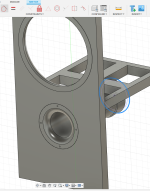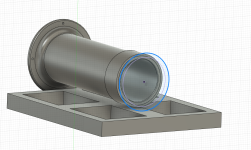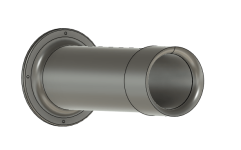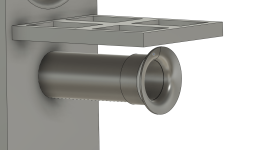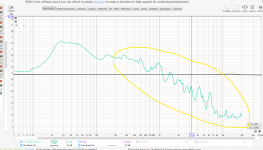Yes.Is this enough space behind the port?
It might result in a very slighty reduced tuning frequency (but you don't need to worry about that, your room influence will be huge compared to a tiny tuning variation).
But you definitely should add a flange with roundover at the inside port end, if you can.
This in general is false. It may be true for some drivers though. There are posts (maybe other forums) where people burn in for 3, 6, 12, 24 hours and the T/S parameters permanently change, even comparing 6 hours of burn in to 24. In many cases the changes don't change the target box modelling much, but in rare cases it really can make you change your entire plans if you relied on manufacturers data.You will see a drop in Fs after pushing the cone, but nothing of significance in the 3rd measurement, even after hours of high excursion.
I can, it will prevent me from being able to swap out the port ever but I guess I won't ever change it anyways.Yes.
It might result in a very slighty reduced tuning frequency (but you don't need to worry about that, your room influence will be huge compared to a tiny tuning variation).
But you definitely should add a flange with roundover at the inside port end, if you can.
I need your opinions. I can flare in the inside of the port but if I do I will have to move the port away from the woofer.
So do I keep it close to woofer or do I move it another half inch and flare the port out?
Alternatively I can flare it a tiny bit, like 1/4 inch, and not hit the brace, leaving the port as close to the woofer as I can get it.
So do I keep it close to woofer or do I move it another half inch and flare the port out?
Alternatively I can flare it a tiny bit, like 1/4 inch, and not hit the brace, leaving the port as close to the woofer as I can get it.
Attachments
That's not important, considering the wavelengths of the useful port output.leaving the port as close to the woofer as I can
It does however make a difference for the "bad" midrange output of the port with a peak at port length resonance, thus I would even try to move the port away from the driver, but not too close to the bottom panel (will cause enclosure heigth resonance to exit the port).
What about placing the port on the rear of the enclosure (even less midrange output)?
I am quite opposed to putting ports on the rear or side. I do understand the theory that low frequencies have no audible port origin buuutttt...... I can hear where it is coming from. I disagree with this theory. For example, when the bar nearby kicks on their subwoofer I can it coming from the bar. Same thing with my neighbor in his garage. I know who kicked on the subwoofer. I cannot hear any of the other frequencies but I can still point source to which side of me the bass is coming from.
I added this. A little bit of a flare.
I can also move it down and make giant flare.
I added this. A little bit of a flare.
I can also move it down and make giant flare.
Attachments
Now with the port moved down the flare can be bigger. I'll probably just do this.
If that cross brace is where the back wall starts then you are wasting time, effort and performance. Why? Because that close to the back wall it effectively extends the port length and poses a 90° turn in the port. That means your tuning will drop a lot lower, equally to a probably 3-4" longer port and the 90° turn introduces losses. If you reduce the length then the virtual extension suddenly drops and you're too short. If you don't want a bend in your port then put it at the top or bottom or - even better - use a passive radiator which will not have the problem of the mid garbage or port noises at all.
Yes, because it either makes higher frequency chuffing noises, distorts and/or it transmits higher frequencies through the port.I can hear where it is coming from.
It's quite hard to avoid high frequencies exiting the port. One possible way is making the speaker a mass loaded transmission line with offset port. I made some tests here.
Edit: by the way a vertical bracing is better in most and also your case. Better not to divide the longest dimension of a speaker box.
The rule of thumb is to keep the port end at least the diameter of the port away from walls / edges.
Not a lot. Just a bit.drop a lot lower,
I did something similar here.
Have a look at the "cap" test.
Edit: by the way a vertical bracing is better in most and also your case. Better not to divide the longest dimension of a speaker box.
Or, if you make such braces, don't put them exactly in the middle or at the exact same distances to each other, even if it doesn't satisfies your OCD. Same distances support resonances, it could make it even worse than without them.
If you get that close as he is here, then it is a lot. You did good experiments but if you repeat that with the back wall instead of a dispersion cone, you'll notice the effect is a lot stronger, none of your examples and measurements come even close to this build.
I haven't found such drastic changes (3" - 4" longer port?). Especially when moving the port slightly in relation to a brace.If that cross brace is where the back wall starts then you are wasting time, effort and performance. Why? Because that close to the back wall it effectively extends the port length and poses a 90° turn in the port. That means your tuning will drop a lot lower, equally to a probably 3-4" longer port and the 90° turn introduces losses. If you reduce the length then the virtual extension suddenly drops and you're too short. If you don't want a bend in your port then put it at the top or bottom or - even better - use a passive radiator which will not have the problem of the mid garbage or port noises at all.
Whilst bends in a port are not desirable, they can be accounted for in the tuning. I don't have hard data that relates "each bend adds X% additional resistance, which results in a tuning change of Y and port length adjustment of Z" data.
If the OP wants to avoid contamination from a shelf brace, dowel (or MDF bracing - say 30mm x 18mm pieces) can be just as effective IMHO
I haven't found such drastic changes (3" - 4" longer port?). Especially when moving the port slightly in relation to a brace.
It looks like the distance to the back wall is well below the diameter of the port, in which case you're reducing the effective diameter of the port - which does lower the fb significantly, I'm sure you are aware of.
That's why I mentioned "minimum port diameter away from walls / edges". I thought your comment was the port "Entrace" in the box being in close proximity to the shelf brace.
Yes, I can push 40 watts before I cross xmax. I won't chuff with a 2" port as long as I flare both endsHave you modelled the port velocity at the expected max power? and also checked cone excursion? i.e. for your desired tuning, this is telling you whether the port has a large enough diameter to avoid chuffing. Being under 17 m/s port velocity is conservative / pretty safe.
This thing will likely never get played at full power. At 1W its at 92 DB.
I think I have it far enough away now. Its lower down and the braces are not actually window braces. I cut them out differently.If that cross brace is where the back wall starts then you are wasting time, effort and performance. Why? Because that close to the back wall it effectively extends the port length and poses a 90° turn in the port. That means your tuning will drop a lot lower, equally to a probably 3-4" longer port and the 90° turn introduces losses. If you reduce the length then the virtual extension suddenly drops and you're too short. If you don't want a bend in your port then put it at the top or bottom or - even better - use a passive radiator which will not have the problem of the mid garbage or port noises at all.
Is this the mid range (yellow) you are trying eliminate from the port? So you put it on the back so all these frequencies die off since they are much more directional than the lower frequency range?
This is a measurement of my port from my last build.
Attachments
I always put my braces at random intervals to make sure any left frequencies in the panels are at least different. I imagine spacing them evenly would leave you with 2-3 sections all resonating at the same frequency right?Or, if you make such braces, don't put them exactly in the middle or at the exact same distances to each other, even if it doesn't satisfies your OCD. Same distances support resonances, it could make it even worse than without them.
- Home
- Loudspeakers
- Multi-Way
- A boring 2 way build
